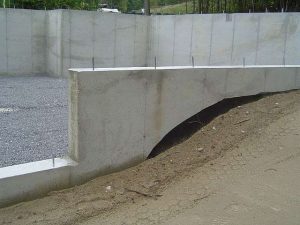Backfill Foundation Walls after they are Fully Cured using a Coarse Grained Soil
By Mark J. Donovan
|
|
Foundation walls are the unsung heroes of a quality built home. They can make, or literally break, a home if installed improperly or are damaged during the backfilling process. Knowing when and how to backfill foundation walls are extremely important bits of information to ensuring that the foundation walls are not damaged.
Wait to Backfill Foundation Walls First, the backfilling of foundation walls should be delayed until the concrete walls are fully cured. |
By definition concrete is considered to be fully cured after 28 days of ideal temperature conditions, the temperature being above 50 degrees Fahrenheit. In addition, backfilling foundation walls should also not be performed until the basement slab has been poured and the foundation walls have been capped with the first floor framing.
| Once the foundation walls are fully cured, have been properly sealed, and the insulation, utilities, and perimeter foundation drainage system installed, the foundation walls can then be backfilled.
How to Backfill Foundation Walls Properly The proper backfilling of foundation walls is critical in the prevention of foundation wall cracks and other structural damages to the home. |
 |
To properly backfill a foundation wall coarse grained soil should be used. It should be first dropped, versus pushed, into place around the corners of the concrete foundation walls. Once the corners of the foundation walls have been evenly backfilled, the sides can then be filled in.
By dropping the soil gently into the void around the foundation walls, versus pushing it into place, the risk of putting too much rapid pressure on the foundation walls is reduced.
By doing so, you will reduce the risk of having to deal with future water problems in the basement and explaining foundation cracks to one day potential homebuyers.
For more help on building a home addition, see HomeAdditionPlus.com’s Home Addition Bid Sheets. Our Home Addition Bid Sheets provide you with the knowledge and information on how to plan a home building project, and what to look for when hiring contractors. They also include detailed cost breakdown tables and spreadsheets for estimating your own new home construction building costs.
Related Information
Free Home Addition Price Quotes with No Obligation!
Fill out our 3-5 minute quick and easy form, and receive a free price quote on a house addition from one of our prescreened and licensed home addition contractors. This process is free and there is no obligation to continue once you receive your house addition price estimate.

